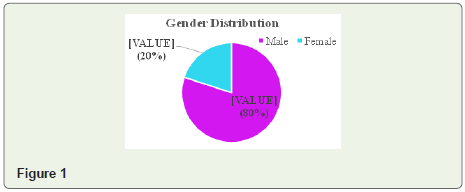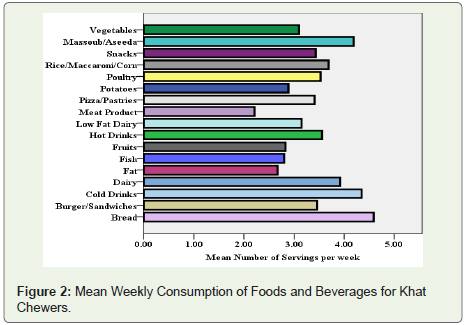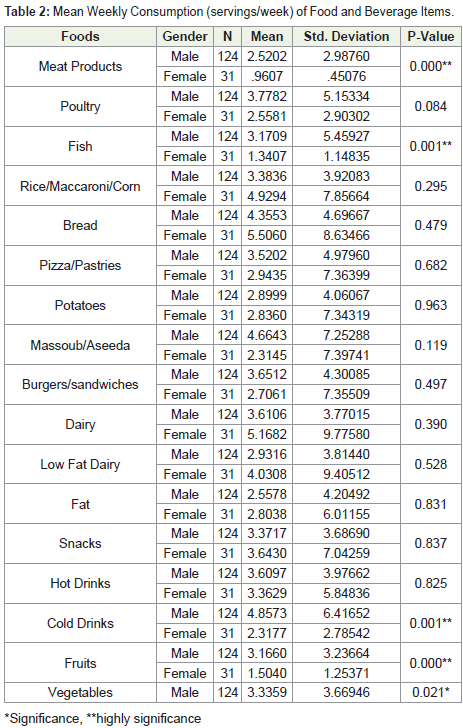Research Article
Dietary Patterns among Khat Chewing Students at Jazan University, KSA
Alsayegh AA*, Chandika RM, Tubaigi AA, Majrashi AM, Meree WA and Asiri AA
Department of Clinical Nutrition, University of Jazan, KSA
*Corresponding author: Abdulrahman A. Alsayegh, Assistant Professor, Department of Clinical Nutrition, College of Applied Medical Sciences, University of Jazan, KSA, E-mail: aalsayegh@jazanu.edu.sa
Article Information: Submission: 18/12/2020; Accepted: 11/01/2021; Published: 15/01/2021
Copyright: © 2021 Alsayegh AA, et al. This is an open access article distributed under the Creative Commons Attribution License, which permits unrestricted use, distribution, and reproduction in any medium, provided the original work is properly cited.
Abstract
Khat is a green leafy plant that is used in many countries including southwest of Saudi Arabia. Around one third of Jazan people chew Khat in which males represent the majority.
Aim: The purpose of the study was to evaluate the dietary patterns and the gender differences among Khat chewing students of Jazan University.
Methods: A cross sectional study conducted using a validated Food Frequency Questionnaire (FFQ) at the Applied Medical Sciences College. Male and
Female Khat chewing students were involved between December 2019 to February 2020.
Results: One hundred and fifty five Khat chewing students participated, among them 124 (80.0%) were male and 31 (20.0%) were female. The most consumed food items by Khat chewing students were bread, cold drinks, and Masoub/Asseda. In addition, more than 50% of the participants consumed poultry, chicken and beef burgers, cream cheese. Our results also showed that male Khat chewers had significantly consumed more red meat, hot drinks and cold drinks, fruits, and vegetables than female. On the other hand, female Khat chewers had significantly consumed more bread and snacks than male Khat chewing students.
Conclusion: Khat chewing students followed unhealthy food habits. Educational sessions are highly advised to improve the nutritional practices.
Keywords
Diet; Food; Nutrition; Food habits; Food frequency questionnaire (FFQ); Dietary patterns; Khat (Catha edulis) and t-test
Introduction and Literature Review
Khat (Catha edulis) is a green leafy plant that grows in southwest
of Arabian Peninsula and extends across the eastern and southern
Africa [1]. Khat is prevalent in many countries such as Ethiopia,
Yemen, Somalia, Turkestan, Afghanistan, Israel and south of Saudi
Arabia 1&3. Patel has described the method of using the plant of
khat. Chewers tend to consume its young leaves garden fresh and they
swallow it’s fluid and took off the rest in sessions manner. In each
session, they chew around 100-500 gm of khat for an average of 3-4
hours per day [2]. The prevalence of Khat chewers in Jazan region,
Saudi Arabia had around 33.2% and the majority of chewers were
male 42.2% compared to female 11.3% [3]. Similarly, it was found that
men have chewed khat more than women in many different countries
such as in Yemen 82% men to 43% women; in Ethiopia 75% men to
around 10 % women; and among Somali community in the United
Kingdom 63% men to 17% women [1,4-8].
Khat was found to improve chewers mood, but caused alertness,
hypertension, tachycardia, and reduced appetite [2]. In addition,
Bani addressed the most common reported diseases in Jazan region
such as hypertension, bronchial asthma, diabetes mellitus, and joint
diseases [9]. Most of these diseases can be prevented by following
healthy dietary patterns [10]. Khat chewers believe that consuming
high calorie foods is important to stay in the stomach for a long
time. This step is used to keep their satiety for a long time while they
chew Khat because they typically chew Khat for at least five hours in
every session [11]. Another study found that college students tend to
consume less fruits and vegetables and more of French fries, Kabsa,
Pizza, and sweets [12]. Hence, assessing Khat chewers food intake is
essential to determine the need of nutrition interventions. As a Jazani
resident who encounter with many Khat chewers, people tend to
consume high calorie foods right before chewing Khat. So, this study
would help to establish a start point to assess the Khat chewers dietary patterns, then fix it as need it to prevent the onset of nutrition-related
diseases. This would be the first study to address the common food
intake among Khat chewers. The aim of the study was to assess the
dietary habits among students who chew Khat and also to find the
gender differences of dietary patterns among khat chewers.
Methods
This is a cross-sectional study where a validated Food Frequency
Questionnaire (FFQ) was distributed among Khat chewer students at
Jazan University [13]. Male and female students were included. There
were no exclusion criteria in this research except those whom do not
chew Khat.
Sample size calculation:
Sample size calculated by using Epidemiological Tools
(EPITOOLS) calculator. The prevalence of Khat chewers in Jazan
region, Saudi Arabia was around 33.2%3. At 5% level of significance,
the desired sample size obtained 145 for a finite population of size
250 at Applied Medical Science College. Finally, 155 Khat chewers
returned the filled questionnaires.Statistical analysis:
The filled questionnaire was collected in a database with
Microsoft Excel 2010. The frequencies of individual food items of
the food frequency questionnaire were transformed into number of
servings per week (servings/week). The studies equated the number
of times “consumption” to “proportions” [14,15]. As in the same
way in the present study the frequency of consumption of each food
item was transformed as follows. The frequency value “+6 times
daily” was transformed to “49 times per week”, “5-6 times daily” was
transformed to “36 times per week”, “2-4 times daily” was transformed
to “28 times per week”, “once daily” was transformed to “7 times per
week”, “5-6 times per week”, was transformed to “6 times per week”,
“2-4 times per week” was transformed to “4 times per week”, “once
weekly” was transformed to “1 per week” and “1-3 times per month”
was transformed to 0.75 times per week”. Obtained data was analyzed
through Statistical Package for Social Sciences (SPSS) 21.0 version.
Independent student t-test for unequal variances was applied for
finding the significance mean differences in the weekly consumption
of food items between male and female Khat chewing students.
P-value less than 0.05 was considered as statistically significant.Results
One hundred and fifty-five Khat chewing students participated
and filled out the questionnaires, among them 124 (80.0%) were male
and 31 (20.0%) were Khat chewing female students (Figure 1).
According to the age distribution, the highest number of the students 126 were between 20-29 year-old. The male samples were 103 (81.7%) and only 23 (18.3%) were Khat chewing female students. However, the least number 5 Khat chewing students were in the age group of younger than 20 year-old (Table 1).
Figure 2 shows the mean number of consumed food items per week. The most consumed food and beverages items were bread (4.58 servings/week), cold drinks (4.35 servings/week), traditional
foods (Massoub/Aseeda) (4.19 servings/week), dairy products (3.92 servings/week), rice/maccaroni/corn (3.69 servings/week), hot drinks (3.56 servings/week), poultry (3.53 servings/week), burgers (3.46 servings/week), snacks (3.43 servings/week), pizza and pastries (3.41 servings/week), low fat dairy (3.15 servings/week), vegetables (3.10 servings/week), potatoes (2.89 servings/week), fruits (2.83 servings/week), fish (2.81 servings/week), fat (2.61 servings/week) and meat products (2.21 servings/week).
Among the meat products, meat with broth was highly consumed compared to kabsa, grilled meat, kabab meat, camel meat and beef. Simple sugar sources such as bread, cold drinks, traditional foods, rice/maccaroni/corn were among the highest consumed food and beverage items.
Table 2 illustrates that the frequency of consumption is influenced by gender differences. Khat chewing male students reported a significantly larger consumption of meat products (2.52 servings/week, P-value 0.000), fish (3.17 servings/week, P-value 0.001), cold drinks (4.86 servings/week, P-value 0.001), fruits (3.17 servings/week, P-value 0.000) and vegetables (3.34 servings/week, P-value 0.02) respectively. Khat chewing male students reported a larger consumption but statistically not significant in pizza/pastries (3.52 servings/week), traditional foods (massoub/aseeda) (4.66 servings/week), burgers (3.65 servings/week), poultry (3.78 servings/week), potatoes (2.90 servings/week) and hot drinks (3.61 servings/week).On the other hand, Khat chewing female students reported excessive consumption but not statistically significance among rice/macaroni/corn and bread (4.93 servings/week and 5.51 servings/week respectively), dairy (5.17 servings/week), low fat dairy (4.03 servings/week), fat (2.80 servings/week) and snacks (3.64 servings/week).
Discussion
The study was conducted to assess and find the dietary patterns and gender differences among Khat chewing students of Applied Medical Sciences College, Jazan University, Kingdom of Saudi Arabia. A study from Saudi Arabia has developed a food frequency questionnaire and tested its reliability and validity [13]. They reported
that 82% and 64.5% of the study participants consumed at least once or more times in a week of chicken kabsa and grilled chicken respectively [13]. Simultaneously, the present study has found that Khat chewing students consumed poultry items 3.17 servings/week.
The study conducted in Italy stated that there was no statistical significance effect by gender in consumption of meat, poultry, and fish products [15]. In contrast, our results found that the consumption of meat and poultry products were statistically significant by gender among Khat chewing students. The results of the present study
were in the same agreement with the study that reported the mean daily consumption of red meat was significantly high in male than female [16], and the mean consumption of meat in male primary school children was 1.7 servings/day [17]. In addition, Khat chewers consumed more animal protein such as meat, chicken and fish products in order to reach their satiety stage [11].
Another study reported that the mean weekly consumption
of bread/cereals among undergraduate students was 5.1 servings/
week [15]. Similarly, the current study addressed that the mean
consumption of bread among male and female Khat chewing
students was 4.93 servings/week. Likewise, other study reported that
85.5% and 77.5% of the participants had consumed white bread and
rice at least once or more times/week respectively [13], while 95.4%
and 81.2% of adolescent and adult girl students daily consumed rice
and wheat respectively [18].
The current study results are in parallel with another study results
in which 60.0% and 54.0% of students had consumed chicken burger
and beef burger at least once or more times/week respectively [13].
The present study results headed to the same direction with the
results of another study that 62% of the students had consumed
cream cheese at least once or more times/week [13]. Male and female
undergraduate students mean weekly consumptions of dairy products
were 4.00 servings/week and 4.24 servings/week respectively [15].
Another study showed that 85% of adolescent and adult student girls
had consumed dairy products daily [18].
The study reported that 45.9% of female students consumed bakery
foods daily, among that, 82.5% consumed sweets, 87.9% consumed
cakes [18]. The mean consumption of nuts was 0.269 servings/daily
in males and 0.243 servings/daily in females [13]. Current study
showed that snacks had been consumed more by female Khat chewers.
Conversely, other study reported that chips, snacks, packaged ready
foods and sauces had been consumed more by male students, but
cakes were consumed more by female students [15].
A study reported that fruit juice consumption in male students
was 2.86 servings/week and in female students was 2.65 servings/
week; the consumption of soft drinks in male students was 3.79
servings/week and in female students was 2.38 servings/week; and the
consumption of coffee/tea was 6.58 servings/week in male students
and was 6.98 servings/week in female students [15]. Furthermore,
other study stated that 72% participants consumed coffee/tea at
least once or more per week [13]. Moreover, a study reported that
fruit juice mean consumption in males was 0.241 servings/daily and
in female was 0.214 servings/daily, whereas there were significant
differences in sugary beverages consumption in males 0.972 servings/
daily than in females 0.699 servings/daily [16]. Similarly, the results of
the current study are in the same agreement that hot drinks and cold
drinks consumption were more in male Khat chewers than in female
Khat chewers.
The study reported that 67% of the students consumed dates
at least once or more on weekly basis and 54% of the participants
consumed banana at least once or more on weekly basis13 and the
study from India reported that 58% of the adolescent and adult
female students consumed fruits daily and 98% of the adolescent and
adult female students consumed banana daily18. Another study from
Italy reported that mean weekly consumption of fresh fruits in male
was 3.39 servings/week and in female was 5.21 servings/week [15].
Hence, the present study observed that overall male Khat chewers
had consumed fruits significantly more times/week than female Khat
chewers.
The study reported that 75% of the study participants consumed
tomato at least once or more on weekly basis and 71% of the
participants consumed lettuce at least once or more on weekly basis
[13]. The study from Italy reported that mean weekly consumption of
raw vegetables in male was 3.46 servings/week and in female was 5.25
servings/week, while male and female consumed 1.92 and 3.63 cooked
vegetables respectively [15]. In addition, another study reported that
vegetables mean consumption in males was 0.904 servings/daily and
in female was 1.032 servings/daily [16]. In contrast, the present study
found that male Khat chewers consumed vegetables significantly
more number of servings/week than female Khat chewers.
Limitation of the study:
Further researches are highly recommended to explore the
associations between demographic variables and food habits in
addition to increase the sample size.Conclusion
The majority of the Khat chewers tempt to follow unhealthy
dietary patterns. Despite to stop Khat chewing habits, it is highly
recommended to provide nutritional education sessions to enhance
the nutritional status.
Acknowledgements
Many thanks to Dr. Ibrahim M. Gosadi, Faculty of Medicine,
Jazan University for his support. We also thank Mrs. Ainum Suhail
for reviewing the paper.
This study was ethically approved and financially supported by
the Deanship of Scientific Research, Jazan University, KSA.




